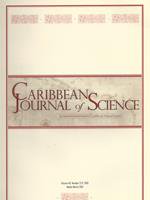Species of decapod crustaceans (crabs) that are either new or imperfectly known as fossils are described from two Pleistocene formations in eastern Jamaica. The first nominal decapod from the early Pleistocene Manchioneal Formation is Herbstia milnei sp. nov., known from a partial carapace. It has a large carapace with short, spinose anterolateral margins; two spines on the posterolateral margins; and a pair of tubercles on each prologastric lobe. All other species are known from the late Pleistocene Port Morant Formation. The hermit crab Dardanus portmorantensis sp. nov. is described from a left propodus. The manus is rectangular, with a straight upper margin bearing three rows of spines, a scaly to granulate outer surface and a sparsely scaled inner surface; the fixed finger is about two thirds the length of manus. Platylambrus sp. cf. F. serratus H. Milne Edwards is recorded from the Port Morant Formation for the first time.
How to translate text using browser tools
1 January 2010
Pleistocene decapod crustaceans of eastern Jamaica
J.S.H. Collins,
S.K. Donovan
ACCESS THE FULL ARTICLE

Caribbean Journal of Science
Vol. 46 • No. 2–3
2010
Vol. 46 • No. 2–3
2010
crabs
Manchioneal Formation
Port Morant Formation
—systematics




